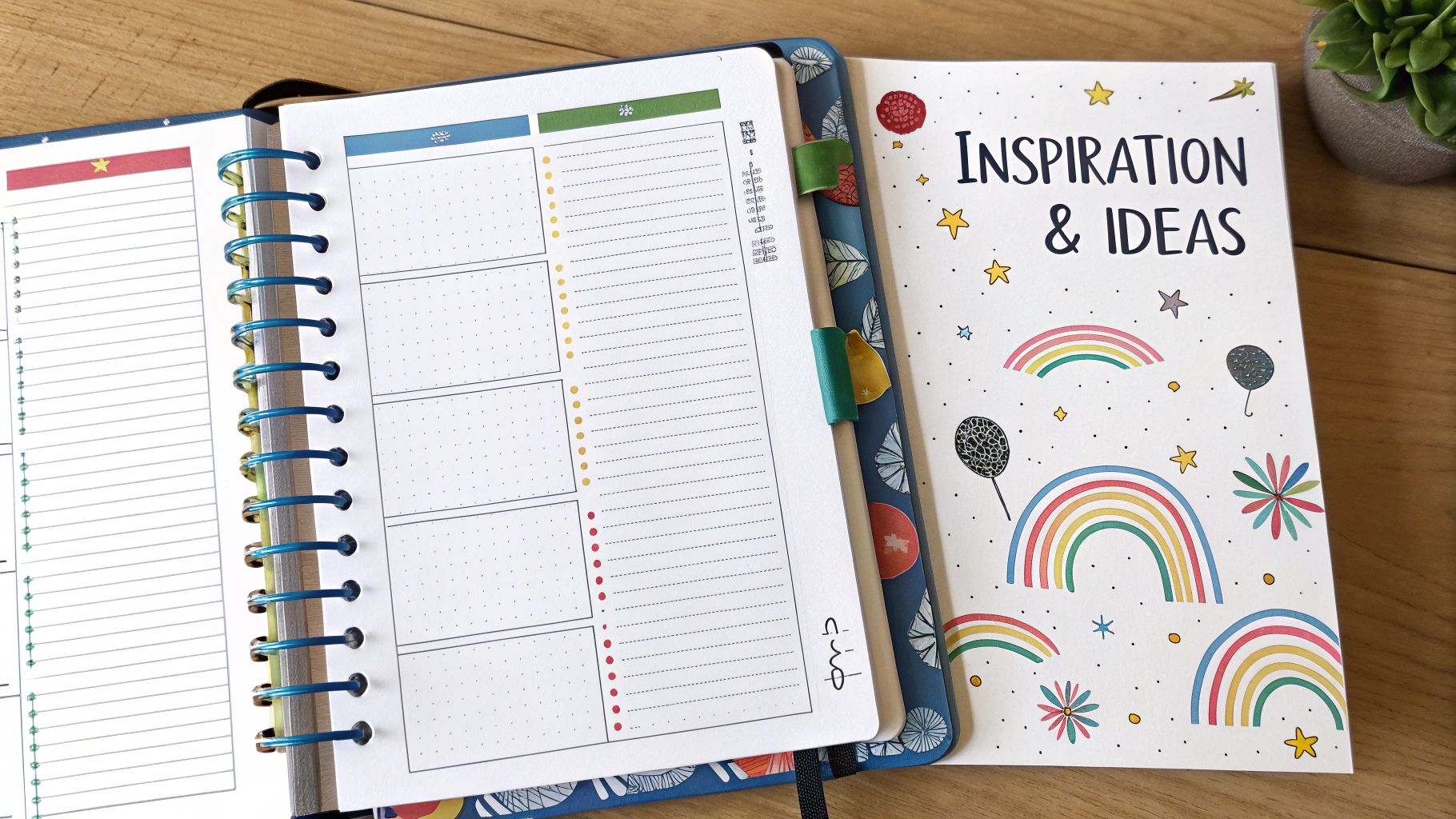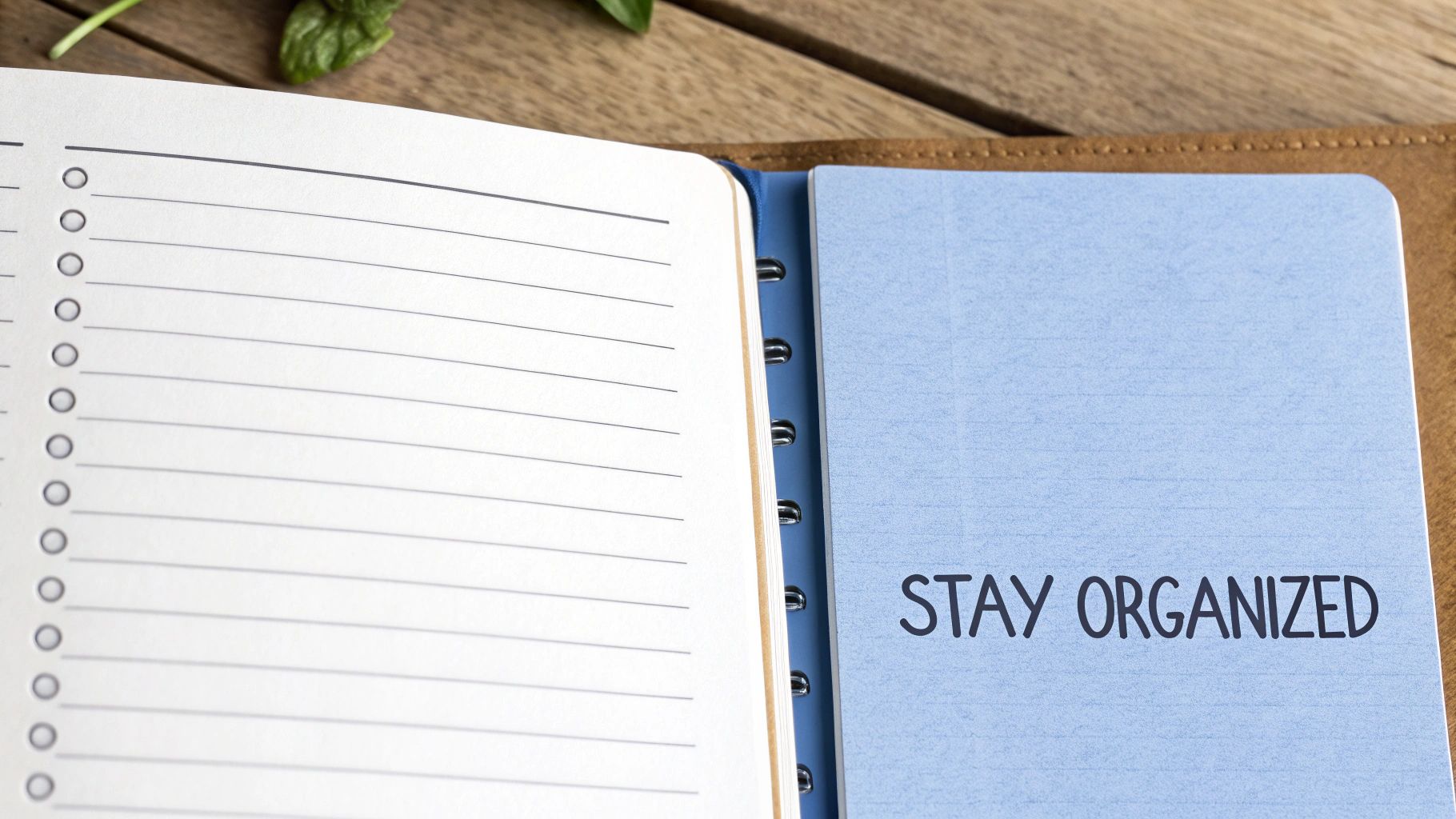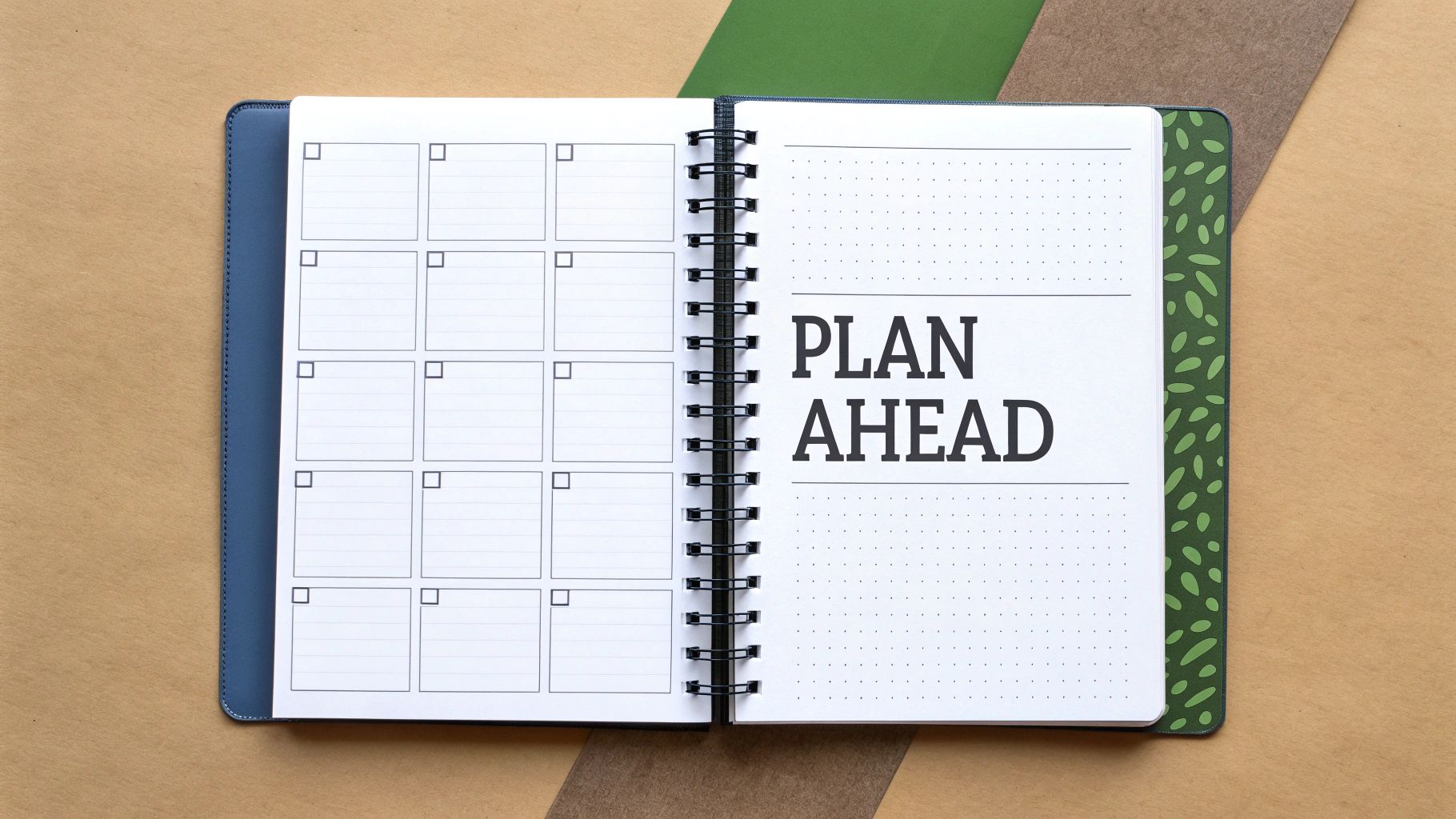The bullet journal (or BuJo) started as a straightforward way to organize daily life. Unlike standard planners with their rigid formats, this flexible system lets you combine to-do lists, notes, and journaling in whatever way works best for you. This freedom to adapt is what makes bullet journaling so appealing.

Each page can be set up differently based on your needs. Some people use their journals mainly for tasks and planning, while others focus on reflection and creative expression. This personal touch helps build a meaningful connection to the practice, unlike pre-printed planners that often have unused sections gathering dust.
The story began when Ryder Carroll launched bulletjournal.com on August 8, 2013, sharing a tutorial video and basic instructions. While traffic was slow at first, features on popular sites like Lifehacker sparked huge interest. By mid-2015, the original video hit one million views, showing just how many people were looking for a better way to stay organized.
From Productivity Hack to Global Movement
At its core, the bullet journal uses just a few simple pieces – the Index, Future Log, Monthly Log, and Daily Log. But the real magic happens when you create custom collections for tracking anything that matters to you, from habits to hobbies. As your needs change, your journal can evolve right along with you.
The Digital Age and the Analog Solution
It may seem strange that paper planners are thriving in our digital world. Yet many find that writing by hand helps them slow down and think more clearly. Working in a physical journal, away from screens and notifications, creates space for focus and reflection. This simple analog tool offers a calming alternative to the constant buzz of digital life.
Essential Pages Every Bullet Journal Needs

Want to create an effective bullet journal? It all starts with setting up a few key pages that work together. These core pages help you organize your thoughts, tasks and reflections in a way that makes sense for you.
The Index: Your Bullet Journal’s Table of Contents
Think of the Index as your journal’s roadmap. Just like a book’s table of contents, this is where you keep track of what’s on each page. As you add new sections, simply note them in the Index with their page numbers. This makes it super easy to find exactly what you’re looking for, even months later.
The Future Log: Planning for the Months Ahead
The Future Log gives you a big picture view of what’s coming up. Break this section into months or quarters and write down important dates, deadlines, and goals. This helps you stay on top of things like birthdays, project due dates, and travel plans before they sneak up on you.
The Monthly Log: A Snapshot of the Current Month
Want to see everything happening this month at a glance? That’s what the Monthly Log is for. Most people include both a calendar view and a task list here. The calendar shows important dates while the task list helps you plan out your monthly goals and to-dos all in one spot.
The Daily Log: Capturing Your Day-to-Day
The Daily Log is where the real action happens. This is your space to track daily tasks, take quick notes, and record events as they happen. Keep entries short and sweet using simple symbols and brief phrases. It’s a great way to stay focused on what matters while creating a meaningful record of your days.
Customizing Your Core Pages
While these main pages create the foundation, the real magic of bullet journaling is making it work for you. Try different layouts until you find your perfect fit – some people love vertical monthly spreads while others prefer horizontal ones. Add some color or decorated headers if that makes it more fun for you. You might find this helpful: How to master the art of journaling for beginners. The key is keeping the basic system working while adding your personal touch. This helps create a journal that’s both practical and enjoyable to use.
The Rise of Creative Planning and Its Impact

One of the best things about bullet journaling is how easily you can make it your own. Each blank page offers endless possibilities for personal expression. This freedom has sparked a huge wave of creative planning, turning what started as a simple organizational method into a place where art meets productivity. But it’s made many wonder – does adding artistic elements help or hurt the main goal of staying organized?
Making Planning Beautiful
Take a look at bullet journals today and you’ll see stunning artwork everywhere. From beautiful hand lettering to colorful drawings and themed monthly layouts, especially on Instagram, bullet journals have become a form of creative expression. This artistic side has helped many people stick with their planning routine by making it more fun and personal. When your monthly spread reflects your personality and interests, you’re more likely to keep using it.
When Art Meets Organization
But there’s a catch to all this creativity. The time spent making elaborate designs could take away from actual planning. Some people get so focused on making their pages look perfect for social media that they lose sight of the real purpose – getting organized. The pressure to create “Instagram-worthy” spreads can be overwhelming and actually make people feel worse about their planning efforts. Learn more about this trend in creative planning here.
Finding Your Sweet Spot
The secret is finding the right mix of creativity and function that works for you. Focus on the essential parts – your index, future log, monthly log, and daily log – while adding your personal touch in ways that help rather than distract.
Here’s how to strike that balance:
- Keep it simple at first: Start with the basics and slowly add creative elements as you get comfortable
- Make decoration meaningful: Use artistic touches to highlight important items or track progress, but avoid cluttering your pages
- Watch the clock: Give yourself time limits for the creative parts so they don’t take over
- Put planning first: Remember why you started – to get organized. Let that guide your creative choices
By following these tips, you can enjoy the creative side of bullet journaling while keeping it practical. The best bullet journals reflect who you are while helping you stay on track – it’s about finding what feels right for you, not what looks best online.
Tools and Supplies for Successful Journaling

Getting started with bullet journaling supplies doesn’t have to be complicated. Let’s explore the essential tools that will help you build a solid journaling practice, focusing on what you really need rather than getting lost in a sea of fancy accessories.
The Heart of It All: Your Notebook
Your notebook is where the magic happens. While there’s no one-size-fits-all solution, a few key features can make a big difference in your journaling experience. Look for a sturdy cover to protect your work, lay-flat binding for comfortable writing, and good paper quality that works well with your favorite pens.
- Dot Grid Notebooks: Perfect balance of structure and creative freedom
- Grid Notebooks: Great for clean, organized layouts
- Lined Notebooks: Ideal for writers and note-takers
The Essential Writing Instrument: Your Pen
Finding the right pen makes all the difference in your daily journaling practice. A comfortable pen that writes smoothly can make you look forward to your journaling sessions. Try different options to find what feels natural in your hand.
- Fineliners: Perfect for clear writing and detailed drawings
- Gel Pens: Smooth writing with fun color options
- Ballpoint Pens: Simple, reliable, and easy to find
Enhancing Your Journaling Experience: Accessories
While you can start with just a notebook and pen, a few well-chosen extras can make your journaling more fun and functional. Remember – only add tools that truly help you achieve your journaling goals.
- Ruler: Makes clean lines and neat layouts
- Washi Tape: Adds color and helps organize sections
- Stencils: Creates consistent symbols and shapes
- Colored Pencils/Markers: Highlights important info and adds visual interest
The bullet journaling trend has brought new life to traditional stationery sales. In the past year alone, U.S. consumers spent $210 million on notebooks – an 18% increase from the previous year. Even marker sales jumped by 17%. Find more stats here.
Choosing the Right Tools for You
Pick tools that match your personal style and needs. Check out our guide on essential bullet journal supplies. Focus on what works for you rather than what looks trendy. Whether you prefer keeping things simple or love adding creative touches, the right tools will help make journaling an enjoyable part of your daily routine.
Customizing Your Bullet Journal for Maximum Impact
A bullet journal is way more than a simple notebook – it’s a system that helps you stay organized and focused. Just like any great tool, it works best when you customize it to match your needs and style. Let me show you how to make every page work harder for you.
Custom Collections: Beyond the Basics
While the core Future Log, Monthly Log, and Daily Log provide a solid framework, the real magic happens when you create custom collections. These are special pages designed just for tracking what matters most to you. Whether you’re building a new habit or managing a big project, dedicated pages help you stay on track and see your progress.
Here are some popular custom collections to try:
- Brain Dump: A space to capture random thoughts and ideas when they pop up
- Goal Setting: Break down your dreams into actionable steps
- Gratitude Log: Write down the good stuff to boost your mood
- Reading List: Keep track of books you want to read and your thoughts on ones you’ve finished
Tailoring Trackers for Personal Insights
Trackers are awesome for spotting patterns in your life, but pre-made ones might not fit your needs. Think about what you really want to monitor – maybe it’s your mood, sleep, exercise, or spending habits. Design trackers that match your goals.
For example, if you run a business, you might track client meetings, marketing efforts, or website stats. This helps you spot trends and make smarter decisions based on real data.
Designing Effective Layouts: Page by Page Structure
Each page should help you get things done. Play around with different layouts until you find what clicks. Some people love clean, minimal designs while others thrive with colorful spreads and decorative touches.
Try these layout styles:
- Vertical Layouts: Perfect for daily logs and to-do lists
- Horizontal Layouts: Great for seeing your week or month at a glance
- Dutch Door Spreads: Cut and fold pages to create sections that stay visible as you flip through
Remember – your journal should make life easier, not harder. If you spend more time making it pretty than using it, maybe simplify things a bit. Check out our tips on how bullet journaling can help with ADHD.
Testing and Refining: Continuous Improvement
Your bullet journal should grow with you. Take time to review what’s working and what isn’t. Are you actually using all your collections? Do your trackers give you helpful insights? Does your layout help you stay productive?
Don’t be afraid to try new ideas and adjust things as your needs change. Keep testing and tweaking until your journal feels just right. The more you fine-tune your system, the better it will serve you in both work and life.
Overcoming Common Bullet Journal Challenges
Creating a bullet journal that works for you is all about making it your own. While this flexibility is wonderful, it can also present some hurdles along the way. Let’s look at some typical challenges and practical ways to handle them.
Staying Consistent
Consistency is often the biggest challenge. When life gets busy, it’s easy to let journaling slip away, leaving half-filled notebooks gathering dust. The secret is making journaling a natural part of your daily routine, just like brushing your teeth. Even a few minutes each day can create lasting benefits.
Try these simple tips:
- Set aside 15 minutes daily for journaling
- Put your journal where you’ll see it frequently
- Begin with basic pages before adding extras
Moving Past Perfectionism
Those beautiful bullet journals on social media can inspire but also intimidate. The pressure to create picture-perfect pages can lead to perfectionism paralysis, making journaling feel more like a burden than a helpful tool. Remember – your journal is for you, not for likes and shares.
Here’s how to overcome perfectionism:
- Make functionality your main focus
- Welcome the occasional mistake or smudge
- Avoid comparing your journal to others’
Keeping It Simple
Many people fall into the trap of overcomplication. Too many trackers and decorative elements can turn your journal from a helpful tool into a source of stress. When your system becomes too complex, it defeats the purpose of bullet journaling.
Try these simplification strategies:
- Check which elements truly help you
- Master basic layouts first
- Keep only the most useful trackers
Managing Planning Stress
Sometimes planning itself can feel overwhelming, especially during busy or unpredictable times. This can make you avoid your journal altogether. The solution is breaking things down into smaller pieces you can handle.
Here’s how to make planning more manageable:
- Plan week by week or day by day
- Put your most important tasks first
- Stay flexible and adjust as needed
By using these practical approaches, you can make your bullet journal work better for you. Remember that bullet journaling is about progress, not perfection. Try different methods and find what fits your life best.
Want to learn more about making the most of your planning tools? Visit Lorelei Web for practical tips on journaling, mind mapping, and other techniques to help you reach your goals.

Lorelei has been an online entrepreneur, marketer and writer since 2006. Her biggest passion is WordPress, which is why she switched to being a full-time blogger 20 years ago and hasn’t looked back since. With so many years of experience behind her, she is an expert in copywriting, SEO, marketing and business strategies.






